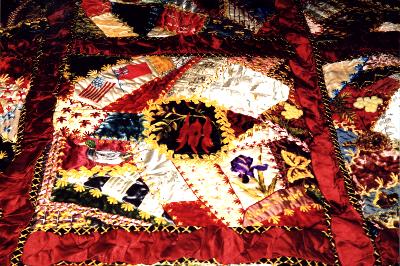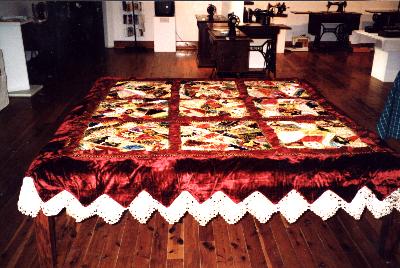Quilt No.488WHS - Wangaratta Historical Society
The quilt was made about 1891 in Wangaratta by Marianne Gibson (1837-1911). It remained in the family until it was presented to Miss Alma Gard and on Alma's retirement she presented it to the Wangaratta Historical Society. It is carefully stored and exhibited occasionally.
"Marianne was born in Armagh, Ireland in 1837, and as a young woman she and her sister accompanied their uncle to Australia. They eventually made their way to Wangaratta Victoria where in 1864, Marianne married Alexander McCullen Gibson.
Mr. Gibson was to become a prominent business man in Wangaratta, establishing a handsome brick building in Reid St, which he operated as a general store and Wine Merchants. The ground floor of the building became the business premises and the first floor which included a pretty balcony became the home of the Gibson family.
Marianne's Obituary which was published in the "Wangaratta Chronicle" in 1911 stated that 'She attended her household in a truly motherly and womanly manner, rearing a family of 3 sons and two daughters.' Unfortunately her Obituary does not identify her daughters by their Christian names.
She also involved herself with women's organisations in the town, particularly the 'Wangaratta Women's Benevolent Society'.
Like many women of her generation she was an experienced needlewoman. The beautiful quilt, known in our society as the 'Gibson quilt' being an example of her considerable skill and pride in her work. This particular quilt was made in 1891."
[Joan Wood, Research Officer, Wangaratta Historical Society 28.10.1996]

Related Quilts:
1800 x 1630mm
2700 x 2700mm
1860 x 1760mm
2439 x 1981mm
2693 x 2490mm








